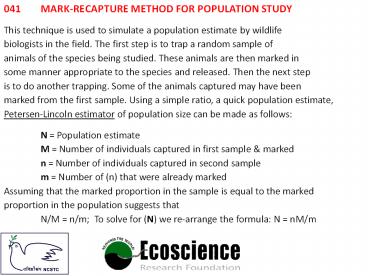041 MARK-RECAPTURE METHOD FOR POPULATION STUDY PowerPoint PPT Presentation
1 / 4
Title: 041 MARK-RECAPTURE METHOD FOR POPULATION STUDY
1
041 MARK-RECAPTURE METHOD FOR POPULATION STUDY
This technique is used to simulate a population
estimate by wildlife biologists in the field.
The first step is to trap a random sample
of animals of the species being studied. These
animals are then marked in some manner
appropriate to the species and released. Then the
next step is to do another trapping. Some of the
animals captured may have been marked from the
first sample. Using a simple ratio, a quick
population estimate, Petersen-Lincoln estimator
of population size can be made as follows N
Population estimate M Number of individuals
captured in first sample marked n Number of
individuals captured in second sample m Number
of (n) that were already marked Assuming that the
marked proportion in the sample is equal to the
marked proportion in the population suggests
that N/M n/m To solve for (N) we re-arrange
the formula N nM/m
2
MATERIALS REQUIRED
White Beads (around 5-6 handfuls) Red Beads
(around 1-2 handfuls Small paper bags
paper bags
White Beads
Coloured Beads
NOTE Red beans such as Rajma and light coloured
beans can also be used to simulate this
experiment
3
PROCEDURE
- Put 5-6 handfuls of white beads into a bag. Do
not count them. - Pick out a handful of these beans and count them
(do not return them to the sack). This is the
first trapping sample (M). Record answer M ___
- To mark these beans merely replace them with
colored beans (red). Now release these marked
individuals (beads) back into the population
(bag). The replaced white beads are set aside and
never returned to the bag again. They were
replaced (marked). - Shake the bag and without looking into the bag
grab another handful of beads. This represents
the second trapping sample (n). Count them and
record the answer. n ___ - How many of the beads in the second trapping
sample were already marked (red beads)? This is
the (m) value. Count them and record the answer.
Return this trapping sample (white and red) to
the bag. m ____ - Now use the equation to calculate the population
estimate (N). N ____
4
FOR EXAMPLE M 16 n 20 m 4 Hence N 16 x
20 /4 80
SECOND CAPTURE n 20 M 4
FIRST CAPTURE (M) 16
DISPERSE

